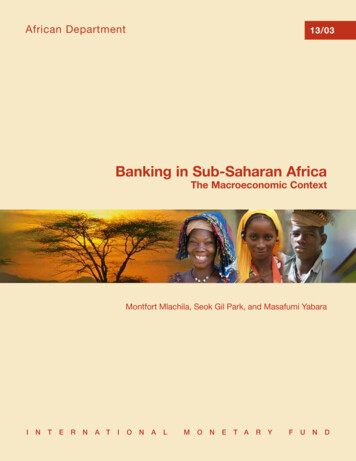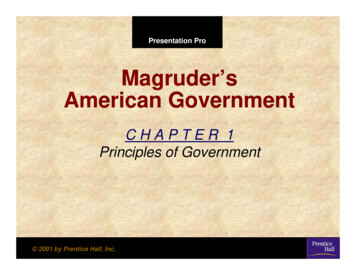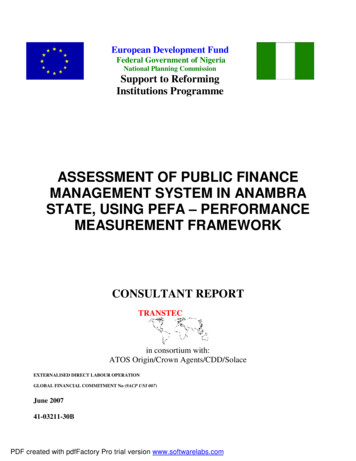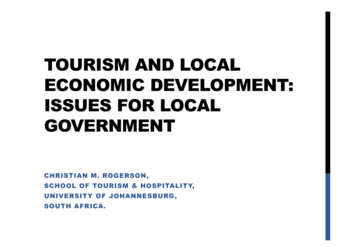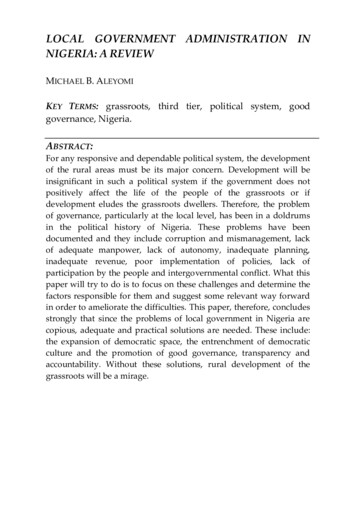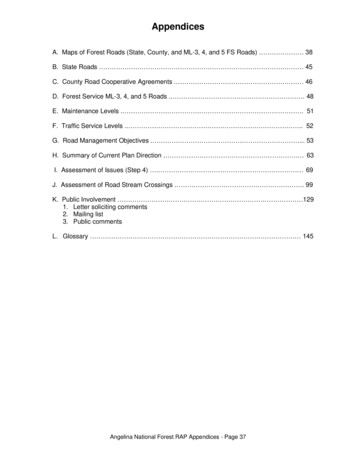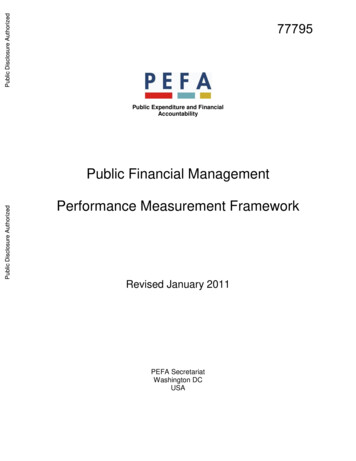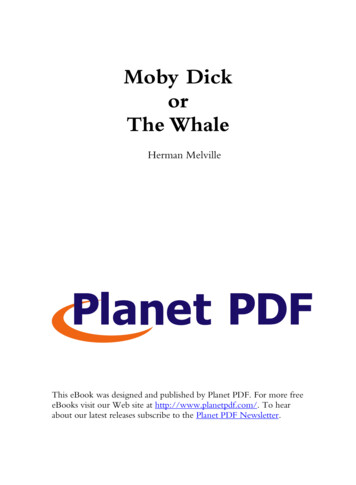
Transcription
FosteringAccountabilitySub-National (Local Government) PEFAAssessment in TanzaniaRorya District Council –Final ReportJuly 2016
Table of ContentsContentsAcronyms41. Summary Assessment71.1. Overview of Ratings71.2. Context of the assessment- Data issues81.3. Integrated Assessment of PFM performance81.4. Assessment of the Impact of PFM weaknesses141.5. Prospects for Reform Planning and Implementation152. Introduction162.1. Objectives162.2. Process of Preparing the Report172.3. Scope of the Assignment and Rationale for Sample192.4. Dependency of Rorya DC on the Central Government203. Country Background223.1. Country Economic Situation223.2. Budgetary Outcomes253.3. Legal and Institutional Framework for Public Financial Management264. LGA Background Information354.1. Economic Situation354.2. Institutional Framework of LGA364.3. Fiscal Performance of LGA375. Assessment of the PFM systems, processes and institutions405.1. Predictability of central transfers405.2. PFM-out-turns: Budget credibility425.3. Key Cross-Cutting Issues: Comprehensiveness and Transparency495.4. Budget Cycle625.5. Donor practices1186. Government Reform Process1196.1. Recent and On-going Reforms1196.2. Institutional Factors Supporting Reform Planning and Implementation121Annexure.1124Data issuesSub-national (Local Government) PEFA Assessment in Tanzania – Rorya District CouncilPwC2
Table of ContentsAnnexure.2 Mapping of Key Weaknesses125Annexure.3 Disclosure of the Quality Assurance Mechanism127Annexure.4 Scoring Methodology under the PEFA Assessment Framework130Annexure.5 Organizational Structure of Ministry of Finance and PM-RALG, Government of Tanzania140Annexure.6 Revenue and expenditure calculations142Annexure.7 Screenshots for HLG-1 Dimension (iii) and PI-1 and PI-2143Annexure.8 Performance indicators summary149Annexure.9 List of people met156Annexure.10159List of Documents Referred toSub-national (Local Government) PEFA Assessment in Tanzania – Rorya District CouncilPwC3
ACGENAccountant GeneralLGFMLocal Government FinancialMemorandumAFROSAIAfrican Organisation of SupremeAudit InstitutionsLGLBLocal Government Loans BoardAFSAnnual Financial StatementsLGRPAIDSALATASDPAcquired Immune DeficiencySyndromeAssociation Local Authorities ofTanzaniaAgriculture Sector DevelopmentProgrammeLGUALocal Government ReformProgrammeLocal Government (UrbanAuthorities) ActLLGLower Level of GovernmentLPOLocal Purchase OrderCAGController and Auditor GeneralMDACBOCommunity Based OrganizationConstituency DevelopmentCatalyst FundMoFMinistries, Departments andAgenciesMinistry of FinanceMSDMedical Store DepartmentCDGCapital Development GrantMTEFCFRCouncil Financial ReportsNACHFCommunity Health FundNAOTCDCFCIAChief Internal AuditorNHIFMedium Term ExpenditureFrameworkNot ApplicableNational Audit Office ofTanzaniaNational Health Insurance FundCMTCouncil Management TeamClassification of Functions of theGovernmentDistrict Agriculture SectorInvestment ProgrammeNMBNational Microfinance BankNRNot RatedDCDistrict CouncilNWSDPDEDDistrict Executive DirectorDepartment for InternationalDevelopmentOSRNational Rural Water Supplyand Sanitation ProgrammeNational Water SectorDevelopment ProgrammeOwn Source RevenuePAAPublic Audit ActDPLODistrict Planning OfficerPCCBEGPAFElizabeth Glaser Pediatric AIDSFoundationPEDPGDPGross Domestic ProductPEFAGFSGovernment Finance StatisticsPETSCOFOGDASIPDFIDNRWSSPPrevention and Combating ofCorruption BureauPrimary Education DevelopmentProgrammePublic Expenditure andFinancial AccountabilityPublic Expenditure andTracking SurveyPFAPublic Finance ActGOTDeutsche Gesellschaft fürInternationale ZusammenarbeitGovernment of TanzaniaPFMGPGGeneral Purpose GrantPFMRPPublic Financial ManagementPublic Financial ManagementReform ProgrammeGIZHCMISHIVHuman Capital ManagementInformation SystemHuman Immunodeficiency VirusPMGPaymaster GeneralPMOPrime Minister OfficeSub-national (Local Government) PEFA Assessment in Tanzania – Rorya District CouncilPwC4
AcronymsHLGHigher Level of GovernmentPMORALGHoDHead of DepartmentPOPSMHROHuman Resource OfficerPPAHSBFHealth Sector Basket FundPPAAIAFInternal Auditor's OfficePPPIAGInternal Auditor GeneralInternational AccountingStandards BoardInternal Audit UnitInformation and CommunicationTechnologyInternational Federation ofAccountantsIntegrated Financial ManagementSystemPPRIIAInstitute of Internal AuditorsRCMISIMFInternational Monetary AACLAAMLGALGAMLGCDGLGDALGFAInternational Association ofSupreme Audit InstitutionsInternational Public SectorAccounting StandardsInternational Standards onAuditingInternational Standards ofSupreme Audit InstitutionsKey Result AreasLocal Authorities AccountsCommitteeLocal Authorities AccountingManualLocal Government AuthorityLocal Government AccountingManualLocal Government CapitalDevelopment GrantLocal Government DistrictAuthorities ActLocal Government Finance ActPrime Minister Office- RegionalAdministration and LocalGovernmentPresident Office-Public SectorManagementPublic Procurement ActPublic Procurement AppealsAuthorityPublic Private PartnershipPSMPublic Procurement RegulationsPublic Procurement RegulatoryAuthorityPublic Sector ManagementPwCPricewaterhouseCoopersRAMRegularity Audit ManualPPRARASRegional AdministrativeSecretariatRevenue ComputerisedManagement InformationSystemRural Water Supply andSanitation ProjectSAISupreme Audit InstitutionSDUService Delivery UnitTACAIDSSecondary EducationDevelopment ProgrammeStrengths, WeaknessesOpportunities And ThreatsTanzania Commission for AIDSTASAFTanzania Social Action FundTBTender BoardTCIConfederation of TanzaniaIndustriesTINTax Identification NumberTRATanzania Revenue AuthorityTZSTanzania ShillingUSDUnited States DollarVATValue Added TaxSEDPSWOTFiscal Year1 July to 30 JuneExchange rate1 USD 2019 Tanzanian Shilling (4th of June, 2015)Symbol “TZS” indicates Tanzania Shillings and “USD” indicatesUnited States DollarSub-national (Local Government) PEFA Assessment in Tanzania – Rorya District CouncilPwC5
AcronymsFinancial PeriodAssessed2011-12 to 2013-14Sub-national (Local Government) PEFA Assessment in Tanzania – Rorya District CouncilPwC6
Summary Assessment1. Summary Assessment1.1. Overview of RatingsTable 1: Overall ratingsSummary tability of transfers from a Higher Level of GovernmentPEFA 2015 ratingNRA. PFM Out-Turns: Budget CredibilityPI-1Aggregate expenditure out-turn compared to original approved budgetPI-2Composition of expenditure out-turn compared to original approvedbudgetPI-3Aggregate revenue out-turn compared to original approved budgetPI-4Stock and monitoring of expenditure arrearsDD DNRB. Key Cross-Cutting Issues: Comprehensiveness and TransparencyPI-5Classification of the budgetCPI-6Comprehensiveness of information included in budget documentsCPI-7Extent of unreported government operationsBPI-8Transparency of inter-governmental fiscal relationsDPI-9Oversight of aggregate fiscal risk from other public sector entitiesCPI-10Public access to key fiscal informationCC. Budget Cycle(i) Policy-Based BudgetingPI-11Orderliness and participation in the budget processC PI-12Multi-year perspective in fiscal planning, expenditure policy, andbudgetingD (ii) Predictability and Control in Budget ExecutionPI-13Transparency of taxpayer obligations and liabilitiesPI-14Effectiveness of measures for taxpayer registration and tax assessmentPI-15Effectiveness of collection of tax paymentsPI-16Predictability in the availability of funds for commitment ofexpendituresDPI-17Recording and management of cash balances, debt and guaranteesCPI-18Effectiveness of payroll controlsD PI-19Competition, value for money and controls in procurementD PI-20Effectiveness of internal controls for non-salary expenditureD Sub-national (Local Government) PEFA Assessment in Tanzania – Rorya District CouncilPwCD DD 7
Summary AssessmentSummary RatingsPI-21Effectiveness of internal auditC (iii) Accounting, Recording and ReportingPI-22Timeliness and regularity of accounts reconciliationBPI-23Availability of information on resources received by service deliveryunitsBPI-24Quality and timeliness of in-year budget reportsC PI-25Quality and timeliness of annual financial statementsB (iv) External Scrutiny and AuditPI-26Scope, nature, and follow-up of external auditC PI-27Legislative scrutiny of the annual budget lawD PI-28Legislative scrutiny of external audit reportsC D. Donor PracticesD-1Predictability of Direct Budget SupportNAD-2Financial information provided by donors for budgeting and reportingon project and program aidNAD-3Proportion of aid that is managed by use of national proceduresNA*NR signifies indicator has been assessed but not rated due to no/insufficient documentation or information providedto the PEFA team, “NA: Not Applicable” implies that the PFM transaction/system/process required for the assessor toassess the indicator/dimension does not exist in the LGA.1.2. Context of the assessment- Data issuesThe variation in data between various source documents referred to in some detail in this assessmentis an area of concern. While the basis of compilation of each document is standardized and wellestablished, reconciliation of different figures from documents such as the MTEF, the NationalBudget, the Audited Annual Financial Statements and others quoted by relevant departments andministries proved to be challenge. However it needs to be mentioned that this phenomena does notapply to this LGA alone but to all the LGAs assessed as a part of the current assignment.Summarized details of the data issues and the solution adopted for this report are provided inAnnexure.1, which are within the stipulations of the PEFA framework and the related instructions inthe PEFA Field Guide. It may be mentioned that the PEFA assessment of seven LGAs in 2006 hadalso referred to enormous variability in numbers between certain key financial documents. Inaddition to this, for certain indicators, relevant information for rating is yet to be made available.Therefore, such indicators/dimensions have not been rated for the purpose of this assessment.1.3. Integrated Assessment of PFM performanceRorya DC has been able to take advantage of the existing institutional structures for PFM in Tanzaniato operate in a challenging environment. These structures include a defined legal and regulatoryenvironment for PFM; well understood planning and budgeting framework; operations throughEPICOR - the Integrated Financial Management System; accounting statements drawn up in lineSub-national (Local Government) PEFA Assessment in Tanzania – Rorya District CouncilPwC8
Summary Assessmentwith IPSAS and the national requirements and audited by the Controller and Auditor General (CAG),an independent oversight authority. The Council Officials, in general, are aware of policies andprocedures as well as expectations. Our assessment has also shown that the LGA relative to otherareas of PFM has performed well in transparency, classification of budget (allowing analysis as perthe development objectives of the Council), and accounting. However, some critical challengesremain. Out of these, some are within LGA’s control and while others are extraneous but affecting itsoperations.The budget credibility in Rorya District Council is low. There are large variations in revenuerealisation as well as expenditure outturn. This is due to various factors such as (i) low predictabilityof central government transfers (ii) weak planning processes (iii) ineffectiveness in revenueadministration systems (iv) weak internal controls and reporting (v) lack of follow-up to externalaudit recommendations.A summary of the key high level weaknesses observed by the Assessment Team and their main causesappear in Annexure.2. The summary also presents the inter-linkages between them as also theagencies having policy, supervisory or oversight responsibilities related to such deficiencies which aretherefore to that extent not within the control of the LGA. The most important of PFM weaknessesin Rorya DC are discussed here.Predictability of Fund FlowsThe dependency of Rorya DC on the funds transferred by the Central Government was nearly 96% ofits total inflows in 2013-14. The uncertainties in their timing and actual availability is a seriousimpediment to the overall planning and budget execution process at the LGA level. Theseuncertainties in cash flows also impacts commitment controls which is further aggravated by lack ofany reliable information on payment arrears.Quality of BudgetingWhile budgeting processes have been formalised, instructions to LGAs are received much after theactual processes have begun on the ground. Much of the groundwork for budgeting at grassroot levelsis based on ceilings of the previous year which have to be reworked once the final ceilings areavailable after discussions at the departments/ministry concerned. Forward planning and estimatesare distorted due to the propensity of extrapolating the past figures into future years through theMTEF and the projections do not appear to be taken seriously thereby undermining structures formedium term fiscal planning. Even though revenue forecasting performance has been relativelysatisfactory as compared with other LGAs with lesser volatility between planned and actuals, theuncertainties in the tax base for critical items such as produce cess coupled with the absence of acredible system for recording tax receivables and arrears on a comprehensive basis show weaknessesin the underlying systems for revenue which need to be handled to ease the over dependence of theLGA on central finances.Controls over Budget ExecutionThe commitment controls systems are in disarray in spite of availability of EPICOR, the accountingsystem that can accommodate ceilings to pre-empt expenditures beyond budgets. This is because ofpurchase orders that are raised outside the system. The comments on under-booking of liabilities bySub-national (Local Government) PEFA Assessment in Tanzania – Rorya District CouncilPwC9
Summary Assessmentthe CAG as a part of his qualifications on the accounts and grave internal control weaknesses intransaction processing and authorisation processes discussed in this report does not give therequired degree of confidence on overall systems of execution control.Accountability Structures and Internal ControlsThough overall accountability structures are well established for LGAs in general, there are severalareas of concern in Rorya DC referred to by both the internal auditors as well as the CAG. Theserelate to compromise of basic financial controls in critical areas such as lack of authorisation ofexpenditure. The lack of a complete tax registration system and failure to account for all receivablesshow the need for strengthening internal systems in these areas. The failure of the Audit Committeeto meet in this context is an area of key concern. Absence of a structured system of follow-up of auditobservations reflects the general weaknesses in overall accountability structures related to PFMfunctions.Credibility of the Budget (PI 1-4 & HLG-1)Local Governments’ dependence on the Central Government fund transfers is high in Tanzania. Theper capita income of Rorya DC is nearly 1/10th of the national per capita income. This leads to lowrevenue base for the Council. In 2013-14, the Council earned 96.5% of its total revenues from theCentral Government grants.The total Central Government transfers were lower than budgeted in all of the last three years (31%,2011-12; 37%, 2012-13 and 20%, 2013-14). On own revenue side, unrealistic forecasts combined withlack of effort by the LGA to raise revenues (as highlighted by CAG) lead to low collections in the lastthree years. In 2012-13 and 2013-14, actual own source revenue collection was 22% and 27% of thebudget respectively which further reduced the resource availability. Apart from the lack of resourcesto spend, issues such as staff shortages, lack of heads of departments, delay in project executionimpacted budget execution. The LGA was able to spend on an average only 3/4th of the budget duringthe last three years. The LGA could improve its performance in 2013-14 from expenditure outturn of60% in 2012-13 to 77% in 2013-14. However, this was possible since the budget size was reduced in2013-14 (by 11%) relative to 2012-13.The impact of poor own source revenue collection and the Central Government transfers were alsoseen in changing priorities of the LGA during the financial year. The compositional variance ofexpenditure was 17%, 32%, 15% in 2011-12, 2012-13, and 2013-14 respectively.In case the government entity excessively delay payments to the creditors, the aggregate expenditureoutturn compared with original budget may not reflect the actual credibility of the budget. Therefore,the monitoring of expenditure arrears is essential to assess the budget credibility. Reliable data onexpenditure arrears in the LGA are not being collected. The expenditure arrears have been clearlybeen defined by the GoT in December 2014. Payables as on 30th of June 2014 were 11.3% of the totalexpenditure.Comprehensiveness and Transparency (PI 5-10)Rorya DC has moved towards Government Finance Statistics (GFS) 2001 based classification of theBudget. This allows the Council to discuss the proposed budgetary allocations taking intoSub-national (Local Government) PEFA Assessment in Tanzania – Rorya District CouncilPwC10
Summary Assessmentconsideration the development objectives. CAG has noticed some anomalies in application of the GFScodes in case of Rorya District Council. There is also no clear evidence of functional classification inline with Classification of the Functions of the Government (COFOG).All funding for donor projects is routed through the Central Government. LGAs do not have anydirect responsibility, administrative or financial, for any autonomous government agency or publicenterprise. Some of the key fiscal information is available for public access such as annual budget andprocurement contracts but there is a scope for improvement.Policy based budgeting (PI 11-12)Though a clear budget calendar is issued by the Central Government for adherence by the LGA andcompliance timelines are tightened for timely budget presentation to the Parliament, the presentsystems allow budgets to be prepared and approved by the Council without consideration of theceiling requirements for the financial year. The late receipt of ceilings for the budget year from MoFnecessitates wide revisions to the originally prepared budget and apart from contributing to uncertaintyin the entire process, also makes it rushed.Linkages between grass root planning processes, budgeting and medium term expenditure forecastsare unstructured and weak. Though there are clear guidelines for MTEF preparations, based onavailable feedback during our discussions at Rorya DC, we understand this has often become anacademic activity of extrapolation of figures.As a consequence, in spite of overlap in the years of coverage in an MTEF, forward year forecasts arenot taken as the basis for budgeting but rather the approved budget of the preceding year. It istherefore, also not surprising that linkage between investment budgets and forward expenditureestimates are fragile.There is a strategic plan reflecting the development priorities of the LGA. However, there is nocosting of interventions in the Strategic Plan. However, we were informed that at present, there wereno legal/administrative requirements specified in Tanzania for such detailed costing of sectorstrategies by the LGAs.Predictability and control in budget executionRevenue Administration Systems (PI 13-15)Based on the GFS (2001) manual, the relevant sources of revenue which can be classified as taxes forRorya DC are (i) Service Levy and (ii) Tobacco cess and other produce cesses. The LGFA (1982)defines the nature of taxes and other revenues of the LGAs. This is to be supported by LGAs’ ownbylaws. Service levy, which constituted on average nearly 6% of total own revenues of the Council in2011-12 to 2013-14, is governed by Local Government Finance Act, 2002 and local byelaw called “Bylaws of Service Levy for the Rorya District Council, 2011”.Though full council meetings as well asWard Executive Officers endeavour to inform taxpayers on the nature of taxes, levies, lack of focusedefforts and absence of any dedicated information desks are setbacks in improving general lowawareness levels of the nature and nuances of each tax and their methods of collection.The Council has a manual database of service levy. But it is not linked to any other databases such asbusiness license for better monitoring of tax compliance. Rorya DC by law states that in case theSub-national (Local Government) PEFA Assessment in Tanzania – Rorya District CouncilPwC11
Summary Assessmentservice levy collector feels that the financial returns do not reflect the true picture, he/she can assessthe liability using their own judgment (Clause 12 (ii) b of the Byelaw). This makes the collection ofservice levy somewhat discretionary. The revenue collected under service levy, tobacco produce cessand other produce cesses once collected is transferred to treasury on an average within a week. TheCouncil collates tax arrears only relating to revenue sources for which collection agents areresponsible. Therefore, under service levy and tobacco cess, no reconciliation is done among taxassessments, collections, and arrear records. However, reconciliation between tax collected andamount transferred to treasury is done on monthly basis.The legislative framework does not provide for any penalty for non-registration with the districtcouncil, but there are penalties for declaration obligations. However, in light of other controlweaknesses in tax collection as well as CAG observations on lack of effort by the DC raises doubtsover effectiveness of these measures.A quick comparison of actual against budgeted tax collections indicates that there has been a highvolatility of collections over the last 3 years. On an aggregate basis (excluding land rent), collectionsagainst budget were 63%, 19% and 38% for years from 2011-12 to 2012-13 and 2013-14 respectively.The overall situation is complicated further with the absence of any independent tax appealsmechanism in the Council.Internal control systems (PI 16- 21)Cash and debt management (PI 16-17): Central Government transfers constitutes significantportion of Rorya DC’s revenues. No information on expected periodic transfers from the CentralGovernment is shared with the District Council. The general uncertainty in the availability and timingof cash flows, therefore, makes any credible cash forecasting a difficult task. There are no cash flowplans of the District Council at the start of the financial year. The District Council also is not in aposition to provide in-year information on ceilings to departments for expenditure commitments.Information on in-year adjustments during the year is not available.From the assessment, the team confirmed that Rorya DC had a debt of 0.1% of its total liabilitieswhich is negligible. Large number of bank accounts that were used previously were later consolidatedto seven accounts only. End year balances for each account is available in the AFS.Payroll Controls (PI-18): With the implementation of Human Capital Management InformationSystem (HCMIS) payroll systems have improved. The Central Government has conducted a majorPayroll cleaning Exercise through which substantial leakages have been corrected. However, there aresome areas which still need to be strengthened. The internal controls over the payroll are still weakalthough the Paymaster General (PMG) had issued the circular requiring all internal auditors toindicate the status of implementation of previous audit recommendations (both CAG and InternalAudit). There are cases of pending arrears related to promotion or new hires. The absence ofdocumented verification at LGA level on changes made to the personnel database and the absence offocused periodic payroll audits reflect the absence of suitable oversight mechanisms in this importantfunctional area.Procurement (PI-19): Although 90% of the procurement is done through competitive bidding, theCAG reported instances where the Council violated procurement laws. There was no clear indicationof the required justification where alternative methods of procurement were adopted. With theimplementation of the Public Procurement Act 2011 , Public Procurement Regulation 2014, and LocalSub-national (Local Government) PEFA Assessment in Tanzania – Rorya District CouncilPwC12
Summary AssessmentGovernment Authorities’ Tender Boards (Establishment And Proceedings) Regulations, 2014 (LGATB), the legislative framework has significantly strengthened. Transparency in public procurement atthe LGA level appears to be broadly in line with the requirements of the Regulation. Procurementnotices are published on the Council’s notice boards as well on the Public Procurement RegulatoryAuthority’s (PPRA’s) website. However, the appeal mechanism needs to be improved.Other Internal Controls (PI-20): Effective commitment control through budgetary ceilingscannot be implemented due to cash rationing with cash limits being fed into the EPICOR system onnotification of actual fund releases obtained from the Central Government. Though this helpsexpenditures to be booked in line with available cash, there are distortions in practice due to localpurchase orders being raised manually outside the EPICOR system. The internal audit reports as wellas CAG audit reports have referred to weaknesses resulting in inadequacy of documentation andrecords and improper authorization of expenditure. Overall operational controls therefore appear tobe requiring appreciable improvements considering the nature of deficiencies observed by theauditors.Internal Audit (PI-21): The quality of the internal audit has been strengthened through ongoingcapacity building initiatives by the Local Government Audit Section at the Internal Auditor General(IAG) Office. Internal audit in Rorya DC is conducted as per the annual risk based audit plan. TheInternal Auditor prepares quarterly audit reports and submits these to the auditees, the CAG and theInternal Auditor General. The time allocation for internal audit is planned according to days beingplanned for audit of various projects, transactions and activities. Audit of bank reconciliations andvisit to service delivery units take place on an ongoing basis. It was difficult to segregate the age ofpast pending issues as the internal audit reports gave no indications on recommendations that hadbeen implemented from the previous year.Accounting, Recording and Reporting (PI 22-25)Rorya DC has seven active bank accounts. Bank reconciliations are performed on all bank accountsand are available by the 15th of the following month for the previous month. With the exception ofMiscellaneous Deposit Cash Account, there is no backlog as bank reconciliations were complete up tothe month of February 2015. There were no unresolved differences between the Council’s cashaccount and the bank statements for all the seven accounts. There are no significant accounts withrecoverable balances existing for more than one year.Information is available at the Council level in terms of resources (both cash and in-kind) that aretransferred to the lower level service delivery units. However, the accounting systems do not captureall the information at the individual service delivery unit level since each unit of the service delivery isnot defined as a cost center. Quarterly reports are available for health, primary and secondaryeducation expenditure.The EPICOR system is not fully operational in Rorya DC. Although the information for preparingfinancial reports is generated through EPICOR, the final reports are prepared manually on MicrosoftExcel. The report provides information on actual expenditure as well as the revenues collected for themonth as well as cumulatively. Information on commitments is not provided in the report. Thereports are in line with GFS 2001 classification used for the annual budget. These reports areprepared on a monthly basis for discussion by the Finance Committee and consolidated on aquarterly basis for discussions by the Full Council.Sub-national (Local Government) PEFA Assessment in Tanzania – Rorya District CouncilPwC13
Summary AssessmentRorya DC prepares its AFS, as confirmed by the CAG, based on the International Public SectorAccounting Standards (IPSAS) and the provisions of the LGFA. Para 31(3) of the LGFM prescribesthe composition of the AFS. The external audit reports showed Rorya DC to be generally incompliance with IPSAS accrual basis of accounting resulting in an unqualified opinion for FY 2013-14and FY 2011-12. The Council however received a qualified opinion in FY 2012-13. The nature of thequalifications has been discussed in the detailed assessment report.External Scrutiny and Audit (PI 26-28)The Laws and Regulations governing external audit includes The Constitution of Tanzania, the LGFA1982, Public Audit Act 2008 and Public Audit Regulations 2009. The external audit of the LGA coversa financial audit as well as the review of internal control systems. The CAG observations on thecontrol weaknesses are provided in the Management Letter to the Council’s Executive Director. Theexternal audit employs a risk based approach and uses systematic sampling to cover transactions insuch a way as to cover major as well as other areas. The National Audit Office is a member of theInternational Organisation of the Supreme Audit Institutions (INTOSAI) and adheres to internationalauditing standards. The emphasis of the audit is financial in nature and performance audit per se isyet to start
Human Capital Management Information System PMG Paymaster General HIV Human Immunodeficiency Virus PMO Prime Minister Office. Acronyms . EPICOR - the Integrated Financial Management System; accounting statements drawn up in line. Summary Assessment Sub-national (Local Government) PEFA Assessment in Tanzania - Rorya District Council .

